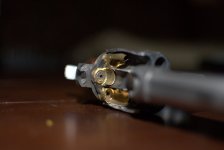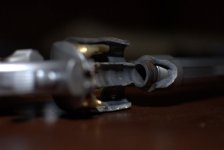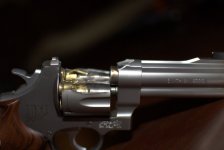I thought I would share my experience with the community here. I had a almost brand new Smith & Wesson 625 Jerry Miculek 45acp completely blow up at the range.
The gun had almost 400 rounds through it, about half factory, half reloads. Took it to the range Friday morning and started shooting it. I was shooting cans at 25yds and having a great time. The loads I was shooting were 5.5grs. of Universal behind a 230gr Hornady XTP, Winchester brass, CCI primer. I had shot 30-40rds and on the 6th shot of my cylinder I felt a jerk downward and felt something whistle past my head. I looked down at my revolver and, well, if you look at the attached pictures you can see what I saw. Fortunately, no one was injured. I never found the missing piece.
I've reloaded over 5,000rds on my Dillon 550 in the last year-rifle and pistol, and have been reloading for many years - so I'm no stranger to reloads. I'm sort of confused at what could have happened. I'm ruling out a double charge because of the rare chance that it would happen on the Dillon powder measure and there would have been powder run-out that I would have noticed. There was absolutely no barrel damage, so it wasn't a squib load followed by a full strength load. The only thing that I can thing of is a brass failure of some sort.
Maybe someone out there that has seen something like this can weigh in with some ideas. In the meantime, this serves as an excellent reminder as to what dangers there are anytime you are at the range. Eye and ear protection are not a suggestion, they are a necessity.
Also, anyone have any suggestions as to what I can do now with it? I assume that S&W will ask what I was shooting, and when I tell them "reloads" they will say sorry and hang up. Either way, I'm calling them on Monday to chat. I have found that it made an excellent conversation piece at a gun show I was at this last weekend....
The gun had almost 400 rounds through it, about half factory, half reloads. Took it to the range Friday morning and started shooting it. I was shooting cans at 25yds and having a great time. The loads I was shooting were 5.5grs. of Universal behind a 230gr Hornady XTP, Winchester brass, CCI primer. I had shot 30-40rds and on the 6th shot of my cylinder I felt a jerk downward and felt something whistle past my head. I looked down at my revolver and, well, if you look at the attached pictures you can see what I saw. Fortunately, no one was injured. I never found the missing piece.
I've reloaded over 5,000rds on my Dillon 550 in the last year-rifle and pistol, and have been reloading for many years - so I'm no stranger to reloads. I'm sort of confused at what could have happened. I'm ruling out a double charge because of the rare chance that it would happen on the Dillon powder measure and there would have been powder run-out that I would have noticed. There was absolutely no barrel damage, so it wasn't a squib load followed by a full strength load. The only thing that I can thing of is a brass failure of some sort.
Maybe someone out there that has seen something like this can weigh in with some ideas. In the meantime, this serves as an excellent reminder as to what dangers there are anytime you are at the range. Eye and ear protection are not a suggestion, they are a necessity.
Also, anyone have any suggestions as to what I can do now with it? I assume that S&W will ask what I was shooting, and when I tell them "reloads" they will say sorry and hang up. Either way, I'm calling them on Monday to chat. I have found that it made an excellent conversation piece at a gun show I was at this last weekend....




